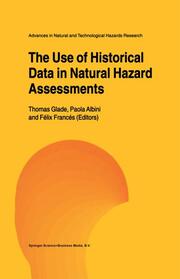Detailansicht
The Use of Historical Data in Natural Hazard Assessments
Advances in Natural and Technological Hazards Research 17
ISBN/EAN: 9789048157624
Umbreit-Nr.: 975828
Sprache:
Englisch
Umfang: xxv, 222 S., 66 s/w Illustr., 3 farbige Illustr.,
Format in cm:
Einband:
kartoniertes Buch
Erschienen am 15.12.2010
Auflage: 1/2001
- Zusatztext
- Natural hazards such as earthquakes, landslides, floods, volcanic eruptions, tsunamis, and hurricanes cause environmental, economic as well as sociological problems worldwide. In recent years, greater availability of information and sensational media reports of natural hazard occurrence -and in particular in terms of property damage or loss oflife caused by these hazards -resulted in an increase of hazard awareness at a societal level. This increase in public awareness has often been misconstrued as an indication that natural hazards have been occurring more frequently with higher magnitudes in recent years/decades, thus causing more damage than in the past. It is still under debate, however, to which extent recent increases in damage can be related to changing frequencies of natural processes, or whether catastrophic events occur at similar rates as they always had. If the latter is the case, the reason for a greater damage can be related to dramatic population growth over the last century, with a substantial augmentation of population density in some regions. Indeed, the implications are more server in underdeveloped and developing countries, where urbanisation has increasingly occurred in hazard prone areas such as coastal zones, alluvial river plains and steep slopes, thus causing an increase in the exposure to natural hazards. Some groups of society in wealthy countries accept higher risks in order to live directly on top of a cliff or on a steep slope to enjoy panoramic views of the landscape.
- Autorenportrait
- InhaltsangabeList of Contributors. Preface. An introduction to the use of historical data in natural hazard assessments; T. Glade, et al. Part A: Earthquakes; P. Albini. Searching for the source of the 1117 earthquake in northern Italy: A multidisciplinary approach; F. Galadini, et al. Sismicité historique des petites Antilles. Un test pour quelques années du milieu du XIXe siècle; J. Vogt. The 1828-1829 earthquake sequence in the provinces of Alicante and Murcia (S-E Spain): Historical sources and macroseismic intensity assessment; P. Albini, F.R. De La Torre. The seismic history of Nicolosi (Catania, Italy); M.S. Barbano, et al. A new macroseismic catalogue for Catalonia; T. Susagna, et al. Expeditious seismic damage scenarios based on intensity data from historical earthquakes; M. Mucciarelli, M. Stucchi. Part B: Flooding; F. Francés. Incorporating non-systematic information to flood frequency analysis using the maximum likelihood estimation method; F. Francés. Historical flood data analysis using AGIS: The Palaeotagus database; M.F. De Villalta, et al. Collaboration between historians and hydrologists on the Ardèche river (France); R. Naulet, et al. Availability and potential of historical flood series in the Iberian Peninsula (14th - 20th centuries); M.-C. Llasat, M. Barriendos. Hydraulic modelling and historical inundation assessment for the Versilia river; S. Pagliara. Part C: Landslide; T. Glade. Landslide hazard assessment and historical landslide data - an inseparable couple? T. Glade. Widespread landslide and flood events in the Catanzaros Isthmus (Calabria, Italy); Relationships with rainfall data; V. Rizzo, et al. The development and application of a historicalbibliography to assess landslide hazard in the United States; C. Alger, E.E. Brabb. The contribution of historical information in the assessment of landslide hazard; D. Calcaterra, M. Parise. Index.
